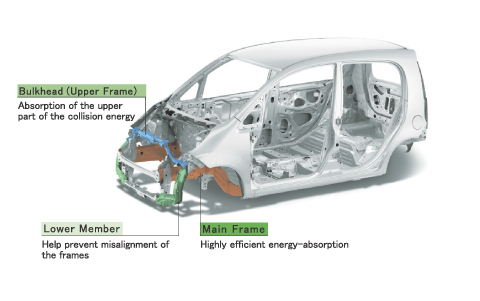September 4, 2003-Honda Motor Co., Ltd. today announced development of a crash compatibility body frame structure that provides greater safety in collisions between vehicles of differing size and weight. The new body design, which builds on Honda's proprietary "G-Control" (G-CON) collision safety body technology, uses the engine compartment to efficiently disperse and absorb collision energy during a vehicle-to-vehicle collision, thus significantly improving self protection while also reducing aggressivity toward other vehicles.
Honda will first use the new body design technology on the all-new Life mini-car, which is scheduled for release September 5th. In the future, during full model changeovers vehicles built on new platforms will be equipped with the new crash compatibility body design.
Honda's new crash compatibility body employs a front-end frame structure that reduces the potential concentrated force of an impact by dispersing and absorbing crash energy over a larger area -- and does not easily become misaligned laterally or vertically with the frame of the other vehicle involved in the crash. The new Honda Life is equipped with a highly efficient energy-absorbing main frame, a bulkhead (upper frame) that absorbs the upper part of the collision energy, and a lower member that helps prevent misalignment of the frames of the vehicles involved. This prevents lateral and vertical misalignment of the frames and disperses and absorbs the collision energy.
In a frontal crash with up to a two-ton-class passenger vehicle (i.e., Legend/RL), the new Life demonstrates improved collision energy absorption of the engine compartment by approximately 50%, while reducing the load on the passenger compartment by some 30%. This reduces the deformation of the passenger compartment during a crash and enhances occupant protection, even as it reduces aggressivity toward the other vehicle.

Crash test of the new Life and a Honda Legend.

Structure of the new Life's crash compatibility body.
In 1998, Honda announced the development of its G-CON collision safety body technology that reduces sudden deceleration on vehicle occupants and helps secure cabin space for their survival. In 2000, Honda set its own new targets in the field of safety, moving ahead with independent research on vehicle-to-vehicle collision safety, including conducting crash tests which more precisely simulate real-world accident conditions. As a result, Honda now has taken G-CON technology another important step forward: this new crash-compatible body provides greater safety in collisions between vehicles of differing size, weight and structural design.
Self-protection performance: Reducing injury to vehicle occupants in a crash and ensuring survival space.
Aggressive behavior toward other vehicles: The one-sided increase in damage inflicted due to excessive concentration of the impact load during a collision between vehicles.